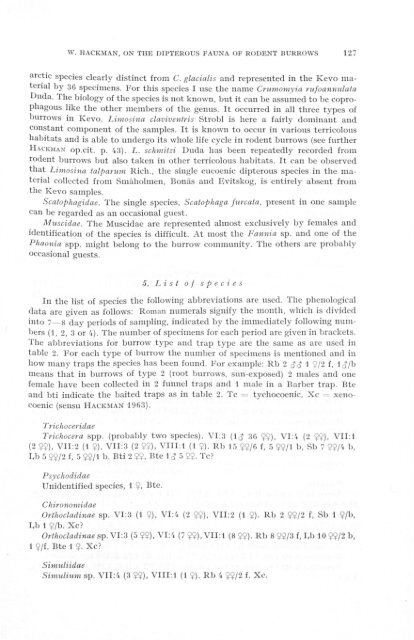NOTULAE ENTOMOLOGICAE - Helda
NOTULAE ENTOMOLOGICAE - Helda
NOTULAE ENTOMOLOGICAE - Helda
Erfolgreiche ePaper selbst erstellen
Machen Sie aus Ihren PDF Publikationen ein blätterbares Flipbook mit unserer einzigartigen Google optimierten e-Paper Software.
\v. HACKMAN, ON THE DIPTEROUS FAUNA OF RODENT I5URROWS 127<br />
arctic species clearly distinct from C. glacialis and represented in the Kevo material<br />
by 36 specimens. For this species I use the name Crumomyia rufoanniilata<br />
L)uda. The biology of the species is not known, but it can be assumed to be coprophagous<br />
like the other members of the genus. It occurred in all three types of<br />
burrows in Kevo. Limosina claviventris Strobl is here a fairly dominant and<br />
constant component of the samples. It is known to occur in various terricolous<br />
habitats and is able to undergo its whole life cycle in rodent burrows (see further<br />
HACKMAN op.cit. p. 43). L. schmitzi Duda has been repeatedly recorded from<br />
rodent burrows but also taken in other terricolous habitats. It can be observed<br />
that Limosina ialparum Rich., the single eucoenic dipterous species in the material<br />
collected from Smäholmen, Bonäs and Kvitskog, is entirely absent from<br />
the Kevo samples.<br />
Scatophagidae. The single species, Scatophaga furcata, present in one sample<br />
can be regarded as an occasional guest.<br />
Muscidae. The Muscidae are represented almost exclusively by females and<br />
identification of the species is difficult. At most the Fannia sp. and one of the<br />
Phaonia spp. might belong to the burrow community. The others are probably<br />
occasional guests.<br />
5. List of species<br />
In the list of species the following abbreviations are used. The phenological<br />
(lata are given as follows: Roman numerals signify the month, which is divided<br />
into 7—8 day periods of sampling, indicated by the immediately following luimhers<br />
(1, 2, 3 or 4). The number of specimens for each period are given in brackets.<br />
The abbreviations for burrow type and trap type are the same as are used in<br />
table 2. For each type of bixrrow the number of specimens is mentioned and in<br />
how many traps the species has been found. For example: Rb 2 1 $/2 f,<br />
means that in burrows of type 2 (root burrows, sun-exposed) 2 males and one<br />
female have been collected in 2 funnel traps and 1 male in a Barber trap. lUe<br />
and l)ti indicate the baited traps as in table 2. To = tychocoenic, Xc xenocoenic<br />
(sensu HACKMAN 1963).<br />
Trichoceridae<br />
Trichocera spp. (probably two species). VI:3 (IcJ 36 ÇÇ), VI:4 (2 ?$), VII: 1<br />
(2 $$), VII:2 (1 $), VII:3 (2 $?), VIIl:! (1 $). Rb 15 $?/6 f, 5 $?/l b, Sb 7 $?/4 b,<br />
Lb 5 $$/2 f, 5 $$/1 b. Bti 2 Bte 1 ^ 5 To?<br />
Psychodidae<br />
Unidentified species, 1 Ç, Bte.<br />
Chironomidae<br />
Orthocladinae sp. VI:3 (1 ?), VI:4 (2 ??), VII:2 (1 $). Rb 2 $$/2 f, vSb 1 Ç/b,<br />
I.b 1 $/b. Xc?<br />
Orthocladinae sp. VI:3 (5 ?$), VI:4 (7 ?9). VII:t (8 ?$). Rb 8 $$/3 f. Lb 10 $$/2 b,<br />
1 $/f. Bte 1 Xc?<br />
Simuliidae<br />
Simulium sp. VI 1:4 (3 $$). VI 11:1 (1 Ç). Rb 4 ??/2 f. Xc.

















